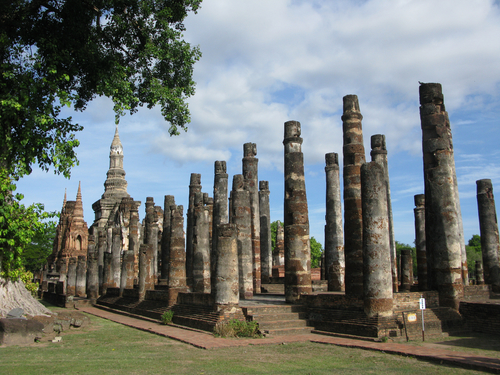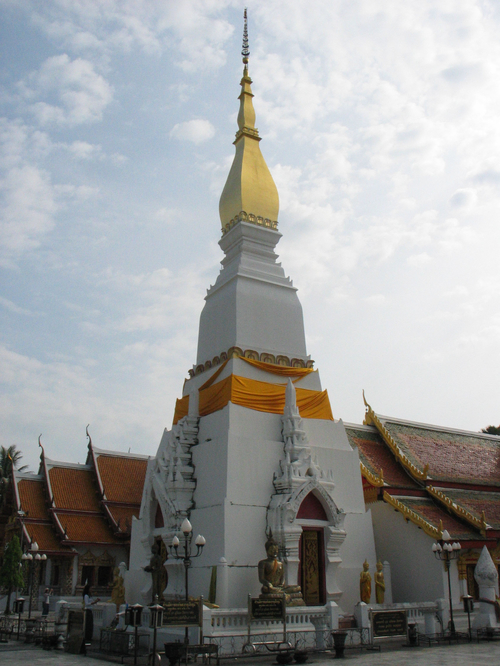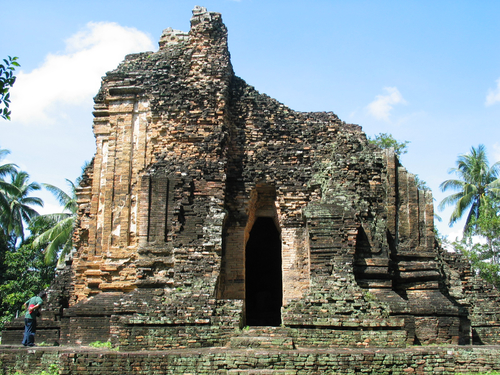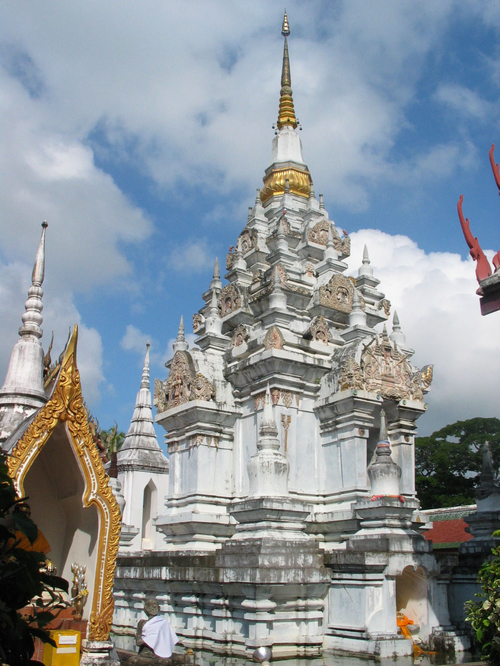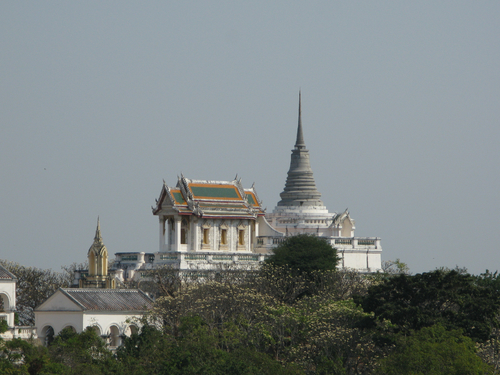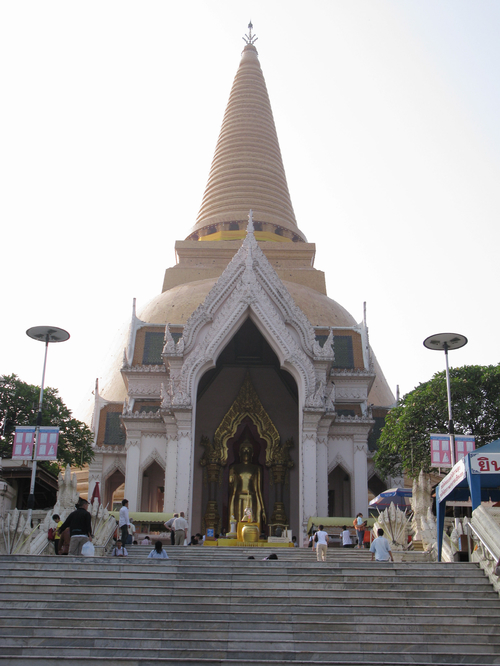ค้นหางานศิลปกรรม
ฐานข้อมูลศิลปกรรมในเอเชียตะวันออกเฉียงใต้
สถาปัตยกรรมวัดมหาธาตุสุโขทัย
วัดมหาธาตุสุโขทัยตั้งอยู่ภายในเมืองสุโขทัย สภาพปัจจุบันเหลือเฉพาะส่วนที่สร้างขึ้นด้วยวัสดุมั่นคงถาวร เช่น อิฐ หิน ศิลาแลง พื้นที่วัดล้อมรอบด้วยแนวกำแพงสี่เหลี่ยม หันหน้าไปทางทิศตะวันออกส่วนที่สำคัญที่สุดคือองค์พระมหาธาตุ ตั้งอยู่กึ่งกลางวัด เป็นเจดีย์ยอดทรงดอกบัวตูม หรือยอดทรงพุ่มข้าวบิณฑ์ แวดล้อมด้วยเจดีย์รายแปดองค์ ด้านหน้าเป็นวิหารหลวง ทั้งหมดนี้ตั้งอยู่ในตำแหน่งแกนกลางของวัด ทางทิศใต้ ตะวันตก และเหนือของแกนกลางนี้มีซากเจดีย์และซากฐานอาคารหลายหลังกระจัดกระจายอยู่ สำหรับอุโบสถตั้งอยู่ทางด้านเหนือของบริเวณวัด
สถาปัตยกรรมพระสมุทรเจดีย์
พระสมุทรเจดีย์มีองค์ประกอบทางสถาปัตยกรรมที่สำคัญ ได้แก่ ส่วนฐานประกอบด้วยฐานเขียงที่มีช้างล้อม ถัดขึ้นไปเป็นฐานประทักษิณ 2 ฐาน ซึ่งมีบันไดทางขึ้นทั้ง 4 ด้าน จากนั้นเป็นชั้นฐานบัวคว่ำ บัวหงายที่ประดับบัวลูกแก้ว 2 เส้น ในผังกลม และประดับจระนำทั้งสี่ทิศที่ชั้นฐานนี้ จากนั้นจึงต่อด้วยชุดฐานบัวคว่ำบัวหงายตามระเบียบของเจดีย์ทรงระฆังในสมัยรัชกาลที่ 4 และมีชุดมาลัยเถา 3 ชั้น ชั้นฐานบัวลูกแก้วอกไก่ 1 ชุด แทนตำแหน่งบัวปากระฆัง องค์ระฆัง บัลลังก์สี่เหลี่ยม แกนปล้องไฉนและเสาหาร ปล้องไฉนทรงกรวยและปลียอด ความสูงของพระสมุทรเจดีย์เป็นผลจากการที่องค์เจดีย์ตั้งอยู่บนฐานประทักษิณที่มีความสูง 2 ชั้น ซึ่งอยู่ในผังแปดเหลี่ยม มีบันไดทางขึ้น โดยฐานประทักษิณชั้นล่างเป็นฐานช้างล้อม การเพิ่มสัดส่วนความสูงด้วยชั้นฐานที่มากขึ้นนั้นเชื่อว่าน่าจะเป็นเหตุผลจากการที่พระสมุทรเจดีย์นั้นเดิมตั้งในบริเวณที่เป็นเกาะกลางน้ำจึงมีความจำเป็นเพื่อป้องกันปัญหาเรื่องน้ำท่วม รวมทั้งเพื่อให้เป็นจุดสังเกตที่สำคัญในการสัญจร
สถาปัตยกรรมพระธาตุเชิงชุม
พระธาตุเชิงชุมเป็นพระธาตุทรงบัวเหลี่ยม ก่ออิฐถือปูนครอบทับปราสาทเขมรที่ก่อจากศิลาแลงพระธาตุเชิงชุมมีแผนผังสี่เหลี่ยม เรือนธาตุมีรูปแบบเป็นชุดฐานเขียงซ้อนลดหลั่นกัน ด้านทั้งสี่มีซุ้มประตูทรงปราสาท ซุ้มด้านตะวันออกเป็นทางเข้าสู่ห้องคูหาที่ตั้งอยู่ภายใน โดยห้องดังกล่าวนี้ก็คือครรภคฤหะเดิมของปราสาทเขมรนั่นเอง ในขณะที่ซุ้มประตูด้านใต้ ตะวันตก และเหนือ แม้ว่าจะผลักบานประตูได้แต่ก็ไม่สามารถเข้าไปภายในได้ เพราะเมื่อผลักเข้าไปจะพบกับผนังประตูหลอกของปราสาทศิลาแลง ถัดขึ้นไปจากเรือนธาตุเป็นองค์ประกอบคล้ายองค์ระฆังแต่อยู่ในผังสี่เหลี่ยม ถัดขึ้นไปเป็นฐานบัวลูกแก้วอกไก่ซึ่งอาจเทียบได้กับบัลลังก์ ถัดขึ้นไปเป็นส่วนยอดที่ประกอบจากบัวเหลี่ยมซ้อนกัน
สถาปัตยกรรมเจดีย์วัดแก้ว
เจดีย์วัดแก้วเป็นเจดีย์ทรงปราสาท ส่วนยอดที่หักหายน่าจะเป็นชั้นซ้อนต่อด้วยองค์ระฆัง คล้ายคลึงกับจันทิในศิลปะชวาภาคกลาง และเป็นทำนองเดียวกันกับพระบรมธาตุไชยาแต่ขนาดใหญ่กว่า ก่อด้วยอิฐและฉาบปูน องค์ประกอบสำคัญประกอบด้วยฐานขนาดใหญ่รองรับองค์เจดีย์ ตัวเจดีย์เป็นทรงปราสาทที่ส่วนยอดพังทลายลงแล้ว หันหน้าไปทางทิศตะวันออก มีแผนผังสี่เหลี่ยมเพิ่มมุม กลางด้านทั้งสี่เป็นมุข ฌเบมุขด้านตะวันออกเป็นทางเข้าสู่ห้องครรภคฤหะ ในขณะที่มุขอีก 3 ด้านเป็นห้องประดิษฐานรูปเคารพ เทียบได้กับแผนผังของจันทิในศิลปะชวาภาคกลางหลายแห่ง ผนังของเรือนธาตุยังประดับตกแต่งด้วยเสาอิงหรือเสาหลอกด้วย
สถาปัตยกรรมพระบรมธาตุไชยา
พระบรมธาตุไชยาเป็นเจดีย์ทรงปราสาทที่มียอดเป็นองค์ระฆัง ก่ออิฐถือปูน ด้านล่างสุดเป็นฐานไพที มีแผนผังสี่เหลี่ยมประดับด้วยเสาหลอกหรือเสาอิงเป็นระยะ มียกเก็จทางด้านตะวันออก มีบันไดทางขึ้นสู่เรือนธาตุอยู่ทางด้านตะวันออกนี้ ด้านบนของฐานไพทีนอกจากจะมีเจดีย์ทรงปราสาทยอดเป็นองค์ระฆังแล้ว ยังแวดล้อมด้วยเจดีย์ทรงกลมตั้งบนฐานบัวสี่เหลี่ยม 6 องค์เจดีย์ทรงปราสาทยอดองค์ระฆังอันเป็นส่วนสำคัญที่สุดประกอบด้วยส่วนฐาน เรือนธาตุ และส่วนยอด ส่วนฐานเป็นฐานบัวที่มีแผนผังยกเก็จล้อตามแผนผังของเรือนธาตุ โดยตัวเรือนธาตุมีแผนผังสี่เหลี่ยมยกเก็จที่กลางด้านและมุมทั้งสี่ เก็จที่กลางด้านทั้งสี่ของเรือนธาตุเป็นมุขยื่นยาว มุขด้านตะวันออกเป็นทางเข้าสู่ห้องครรภคฤหะ ในขณะที่มุขอีก 3 ด้านทึบตัน เก็จที่มุมทั้งสี่ของเรือนธาตุเป็นเสาอิงหรือเสาหลอก ส่วนยอดถัดขึ้นไปจากส่วนเรือนธาตุ ประกอบด้วยชั้นซ้อน 2 ชั้น แต่ละชั้นมีเจดีย์ทรงกลมล้อมรอบอยู่ ถัดขึ้นไปเป็นฐานแปดเหลี่ยมซึ่งมีเจดีย์ทรงกลมล้อมรอบ จากนั้นเป็นบัวคลุ่ม องค์ระฆังแปดเหลี่ยม บัลลังก์ ปล้องไฉน และปลี อันเป็นระเบียบของเจดีย์ทรงกลม
สถาปัตยกรรมวัดพระแก้วน้อย
สถาปัตยกรรมที่สำคัญของวัดพระแก้วน้อย ได้แก่ พระอุโบสถ และพระสุทธเสลเจดีย์ ส่วนพระอุโบสถเป็นอาคารก่อด้วยหินอ่อนในผังสี่เหลี่ยมผืนผ้า หลังคาประดับกระเบื้องซ้อนชั้น เครื่องลำยองประดับลวดลายปูนปั้นรูปพระมหามงกุฎประดิษฐานบนพานแว่นฟ้า ขนาบสองข้างด้วยฉัตร 5 ชั้น พื้นหลังเป็นลายก้านขด ซึ่งเป็นฝีมือช่างเพชรบุรี ผนังพระอุโบสถเขียนภาพจิตรกรรมลายพรรณพฤกษา ซุ้มประตูหน้าต่างด้านนอกประดับลวดลายปูนปั้น ภายในพระอุโบสถประดิษฐานพระนิรัยตรายจำลองและพระแก้วมรกตจำลองส่วนพระสุทธเสลเจดีย์ เป็นเจดีย์ทรงระฆังตั้งอยู่ด้านหลังพระอุโบสถโดยมีทางเชื่อมต่อขึ้นไปยังฐานประทักษิณรอบองค์เจดีย์ องค์เจดีย์ก่อด้วยหินอ่อนที่รัชกาลที่ 4 โปรดเกล้าฯ ให้ตัดมาจากเกาะสีชัง จ.ชลบุรี เรียงต่อกันตามแบบของเจดีย์ทรงระฆังซึ่งเป็นพระราชนิยม ทั้งนี้ได้โปรดเกล้าฯ ให้มีการบรรจุพระบรมสารีริกธาตุไว้ภายในพระเจดีย์ด้วย
สถาปัตยกรรมพระปฐมเจดีย์
พระปฐมเจดีย์เป็นเจดีย์ทรงระฆังในผังกลมที่มีขนาดสูงใหญ่ที่สุดในประเทศไทย ตั้งอยู่บนฐานประทักษิณที่มีระเบียงคดในผังกลมล้อมรอบองค์เจดีย์ โดยมีวิหารทิศทั้ง 4 คั่นจังหวะ ได้แก่ วิหารทิศเหนือประดิษฐานพระพุทธรูปตอนประสูติ วิหารทิศตะวันออกประดิษฐานพระพุทธรูปตอนตรัสรู้ วิหารทิศใต้ประดิษฐานพระพุทธรูปตอนปฐมเทศนา และวิหารทิศตะวันตกประดิษฐานพระพุทธรูปตอนปรินิพพาน องค์พระปฐมเจดีย์ประกอบด้วยส่วนฐานซึ่งเป็นฐานบัวคว่ำบัวหงาย มีส่วนรองรับองค์ระฆังเป็นชุดมาลัยเถารองรับองค์ระฆังขนาดใหญ่ ถัดขึ้นไปเป็นบัลลังก์สี่เหลี่ยม แกนปล้องไฉนที่มีเสาหาร ปล้องไฉน และปลียอดที่มีลักษณะอ้วนป้อม
สถาปัตยกรรมปรางค์พระศรีรัตนมหาธาตุลพบุรี
ปรางค์พระศรีรัตนมหาธาตุลพบุรีตั้งอยู่บนฐานไพที หันหน้าไปทางทิศตะวันออก ทางเหนือและใต้เคยมีปรางค์องค์เล็กๆ ขนาบข้างอยู่ ปัจจุบันพังทลายหมดแล้ว ปรางค์พระศรีรัตนมหาธาตุก่อด้วยศิลาแลงเป็นวัสดุหลัก ฉาบปูนและประดับตกแต่งด้วยปูนปั้น ภายในเรือนธาตุมีห้องคูหาหรือห้องครรภคฤหะ ด้านหน้าเป็นตรีมุขต่อยื่นยาวออกมา สามารถเข้าไปภายในได้ ส่วนอีก 3 ด้านเป็นมุขสั้น ส่วนยอดหรือหลังคาเหนือเรือนธาตุทำซ้อนลดหลั่นกันขึ้นไป ยังคงเห็นการประดับตกชั้นซ้อนแต่ละชั้นด้วยกลีบขนุน
